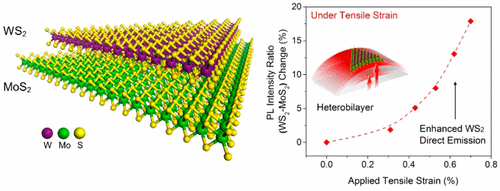
Sangyeon Pak et al., Nano Letters, 17, 5634, 2017
Abstract
van der Waals heterostructures composed of two different monolayer crystals have recently attracted attention as a powerful and versatile platform for studying fundamental physics, as well as having great potential in future functional devices because of the diversity in the band alignments and the unique interlayer coupling that occurs at the heterojunction interface. However, despite these attractive features, a fundamental understanding of the underlying physics accounting for the effect of interlayer coupling on the interactions between electrons, photons, and phonons in the stacked heterobilayer is still lacking. Here, we demonstrate a detailed analysis of the strain-dependent excitonic behavior of an epitaxially grown MoS2/WS2 vertical heterostructure under uniaxial tensile and compressive strain that enables the interlayer interactions to be modulated along with the electronic band structure. We find that the strain-modulated interlayer coupling directly affects the characteristic combined vibrational and excitonic properties of each monolayer in the heterobilayer. It is further revealed that the relative photoluminescence intensity ratio of WS2 to MoS2 in our heterobilayer increases monotonically with tensile strain and decreases with compressive strain. We attribute the strain-dependent emission behavior of the heterobilayer to the modulation of the band structure for each monolayer, which is dictated by the alterations in the band gap transitions. These findings present an important pathway toward designing heterostructures and flexible devices.